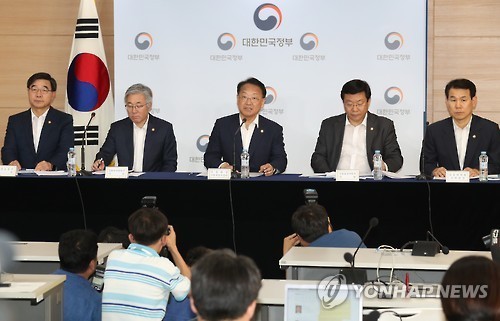South Korea on Friday outlined an 11 trillion won ($9.64 billion) extra budget plan designed to prop up its economy facing sluggish exports and a possible fallout from corporate restructuring in key industries.
It is part of the government's 28 trillion won economic stimulus package aimed at helping Asia's fourth-largest economy achieve 2.8 percent growth this year, which was downgraded last month from an earlier 3.1 percent.

Passed by the Cabinet, the supplementary budget will be submitted to the National Assembly on Tuesday next week as the government hopes that the parliament will give approval around Aug. 12, so the funds can be released before September.
"We have been going through corporate restructuring as part of our efforts to steer the economy to a more advanced one. At the same time, we are experiencing rising unemployment in the young generation and escalated financial uncertainties stemming from the British exit from the European Union, or Brexit," Vice Finance Minister Song Eon-seog said in a prior press briefing in Sejong.
"The government has come up with the extra budget plan to deal with the tight job market."
The government's extra spending came as ongoing strict restructuring efforts in the shipbuilding and other shaky sectors weighed heavily on the local job market and the entire economy, as key indicators are showing that it is still in the doldrums.
South Korea's exports, one of the core economic drivers, fell 10 percent on-year in the January-June period, posting the 18th consecutive negative growth at the same time. Outbound shipments fell 2.7 percent in June, with exports of key items, like cars, machinery and petroleum products, marking negative growth last month.
Private consumption has been the only positive side that offset the slump on the production side. Domestic consumption continued their upbeat mode in May, as retail sales advanced 5.1 percent in May on the back of robust sales of durable goods like passenger cars.
The country's unemployment rate stood at 3.6 percent in June, but that for young people aged between 15 and 29 reached 10.3 percent last month, up from May's 9.7 percent, marking the highest-ever number for the month of June.
The unemployment rate for those aged under 29 hit an all-time high of 12.5 percent in February.
Full-scale restructuring in the labor-intensive shipbuilding industry has inflated such figures in the regions where major shipyards are located.
The unemployment rate in Ulsan, where the country's No. 1 shipyard Hyundai Heavy Industries Co. is headquartered, gained 0.4 percentage point on-year to 3.6 percent, while South Gyeongsang Province, where other major shipbuilders are located, saw its rate soar 1 percentage point to 3.9 percent over the one-year period.
South Korean shipbuilders, including industry leader Hyundai Heavy Industries and Daewoo Shipbuilding & Marine Engineering Co., have been under severe financial strain in the face of a fall in new orders amid a protracted slump in the world's economy. They announced self-rescue plans, including asset sales and downsizing, which will likely bring about massive layoffs in the shipbuilding sector.
The central bank also slashed the growth target for 2016 by 0.1 percentage point to 2.7 percent, citing rising uncertainties at home and abroad, following a cut in the base rate to a record low of 1.25 percent last month.
Against this backdrop, international organizations like the International Monetary Fund and the Organization for Economic Cooperation and Development called for more aggressive fiscal intervention into the economy.
The Ministry of Strategy and Finance said it will focus on minimizing fallout from ongoing restructuring in the job market and supporting the regions.
According to the ministry, the proposed 11 trillion won extra budget plan showed that 9.8 trillion won will be used to stimulate the economy, with the remaining 1.2 trillion won to go to pay back the state debts.
Out of the 9.8 trillion won fiscal program, 1.9 trillion won will be set aside to support the corporate restructuring efforts and another 1.9 trillion won will be spent to create jobs and boost the real economy. Some 2.3 trillion won will be injected into the shipyard cluster areas to prevent a sudden economic slump, with 3.7 trillion won to finance local provincial government budgets.
As part of the program, the government will send out orders for 61 vessels such as patrol boats and warships in order to help small and medium-sized shipbuilders survive, while it will pour out an additional 400 billion won in public credit guarantee funds to ease their cash flow problems.
It also includes a plan to increase the foreign exchange stabilization fund by 500 billion won to get prepared preemptively against possible financial turmoil in the aftermath of the Brexit.
Separate from the supplementary budget, at the same time, the government said it will spend an additional 17 trillion won to increase investments and foster domestic demand by encouraging state-run companies to make large-scale investments and expand state-run trade funds.
With a total of 28 trillion won in increased fiscal spending, the government forecast that it will likely push up economic growth by 0.1 and 0.2 percentage point this year and create 68,000 new jobs.
The finance ministry added that the proposed extra budget will decrease the country's debt-to-gross-domestic-product ratio to 39.3 percent from the current 40.1 percent, as it will be financed with a tax surplus and others, without selling state bonds. (Yonhap)





![[Exclusive] Hyundai Mobis eyes closer ties with BYD](http://res.heraldm.com/phpwas/restmb_idxmake.php?idx=644&simg=/content/image/2024/11/25/20241125050044_0.jpg)
![[Herald Review] 'Gangnam B-Side' combines social realism with masterful suspense, performance](http://res.heraldm.com/phpwas/restmb_idxmake.php?idx=644&simg=/content/image/2024/11/25/20241125050072_0.jpg)

